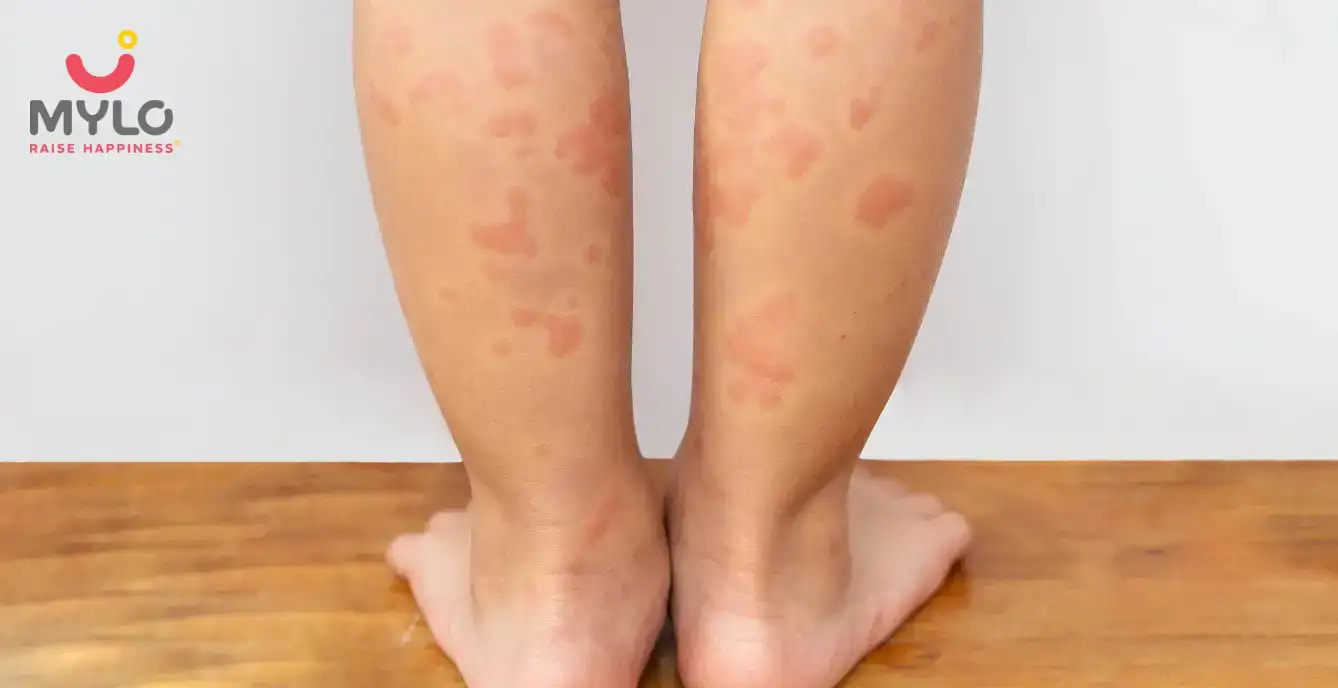In this Article
Allergies
Treatment for Hives in toddlers
Updated on 29 January 2022
Your baby's skin is extremely sensitive at this age, and hence, the effect of any skin infection instantly shows on your baby's skin. Hives are raised and swollen areas on your baby's skin which cause a lot of itchiness in your baby's skin. They result from the human body's reaction to allergens. Hives are alternatively also known as nettle rash, wheals, welts, swellings, and in medical terms- Urticaria!
Your baby could have Hives because of several factors such as viral infections, bacterial infections, allergies to certain foods, allergies to medicines, bug bites or bee stings, temperature changes, cow's milk if you introduce it before six months, and petting pets!
Home Remedies to Treat Hives in toddlers
In the initial stages, you can always try home remedies before rushing to a doctor. Here are a few things you can do at home:
-
To soothe the itching, apply calamine lotion to the affected area.
-
Cut your baby's nails and remove any dirt if present, not to hurt themselves while trying to scratch.
-
Wrap a piece of ice in a muslin cloth and rub it on the rash.
-
Dress your baby in cotton clothes to provide comfort and reduce skin irritation.
-
Give your child a cold bath with a punch of baking soda in the water. This will help in soothing the skin.
Treatment for Hives in toddlers
Hives usually vanish on their own in a few hours or a few days. But, if you notice that the hives just wouldn't go, consult a pediatrician. He would usually prescribe the following:
-
Antihistamine
Antihistamines such as cetirizine can help relieve itching and swelling caused by hives.
-
Histamine Blockers
Histamine blockers can be taken orally or injected to help treat hives. Cimetidine and ranitidine
are commonly used, although they might cause indigestion.
-
Steroids
If over-the-counter treatment does not work, the doctor may prescribe stronger topical or oral corticosteroids, such as prednisone. These are only used briefly.
-
Getting asthma drug injected
Injections of the asthma medicine omalizumab have been shown to relieve hives without any side effects. It is more expensive than other treatments.
-
Asthma and Antihistamine Combination
In severe situations of hive outbreaks, the doctor may prescribe an antihistamine over-the-counter. These can affect a child's behavior and mood.
6. Immunosuppressants
Immunosuppressants may be required for chronic hives. Cyclosporine and tacrolimus suppress the immune system's response to hives, although they cause headaches and nausea.



Written by
Priyanka Verma
Priyanka is an experienced editor & content writer with great attention to detail. Mother to an 11-year-old, she's a ski
Read MoreGet baby's diet chart, and growth tips

Related Articles
Related Questions
Hello frnds..still no pain...doctor said head fix nhi hua hai..bt vagina me pain hai aur back pain bhi... anyone having same issues??

Kon kon c chije aisi hai jo pregnancy mei gas acidity jalan karti hain... Koi btayega plz bcz mujhe aksar khane ke baad hi samagh aata hai ki is chij se gas acidity jalan ho gyi hai. Please share your knowledge

I am 13 week pregnancy. Anyone having Storione-xt tablet. It better to have morning or night ???

Hlo to be moms....i hv a query...in my 9.5 wk i feel body joint pain like in ankle, knee, wrist, shoulder, toes....pain intensity is high...i cnt sleep....what should i do pls help....cn i cosult my doc.

Influenza and boostrix injection kisiko laga hai kya 8 month pregnancy me and q lagta hai ye plz reply me

RECENTLY PUBLISHED ARTICLES
our most recent articles

General Father
Tips for New Dads to Make Friends with Other Fathers

General Father
Are You a Millennial Parent? Find Out

General Father
How to Choose a Gynaecologist for Your Pregnant Wife?

Illnesses & Infections
Wheezing in toddlers: How to treat?

Cold & Cough
How can steam inhalation help my baby's blocked nose?

Illnesses & Infections
How to cure ringworm in toddlers
- Coronavirus, pregnancy, and New Year travel, how to balance all three at the same time?
- 12 tips for easing your 'parent-noia'
- How to pack your wife's hospital bag
- How to Travel with a Baby for a New Father
- Looking for a perfect name for your baby? Here's how you can find it
- 14 Month Old Baby Food Chart/Feeding Schedule – Week 2
- How to treat head lice & nits in babies
- Educating Your toddler about Covid
- Top 7 Secrets of your baby's behavior
- Top Gadgets for Every New Parent
- New Mom Diet Plan – Month 11 Week 43
- 13 Month Old Baby Food Chart/Feeding Schedule – Week 3
- 13 Month Old Baby Food Chart/Feeding Schedule – Week 1
- Baby Diet Plan - Month 13


AWARDS AND RECOGNITION
Mylo wins Forbes D2C Disruptor award
Mylo wins The Economic Times Promising Brands 2022
AS SEEN IN
















At Mylo, we help young parents raise happy and healthy families with our innovative new-age solutions:
- Mylo Care: Effective and science-backed personal care and wellness solutions for a joyful you.
- Mylo Baby: Science-backed, gentle and effective personal care & hygiene range for your little one.
- Mylo Community: Trusted and empathetic community of 10mn+ parents and experts.
Product Categories
baby carrier | baby soap | baby wipes | stretch marks cream | baby cream | baby shampoo | baby massage oil | baby hair oil | stretch marks oil | baby body wash | baby powder | baby lotion | diaper rash cream | newborn diapers | teether | baby kajal | baby diapers | cloth diapers |





